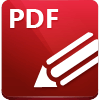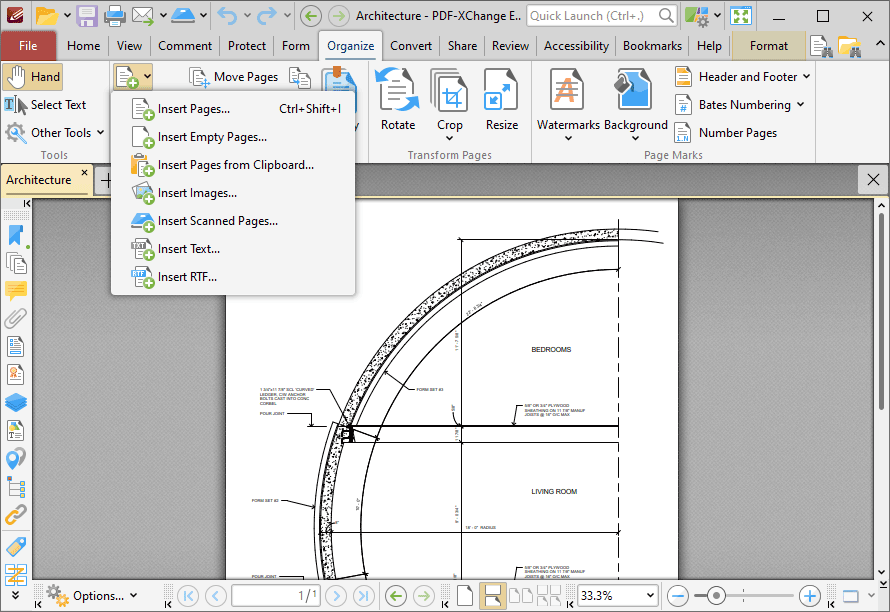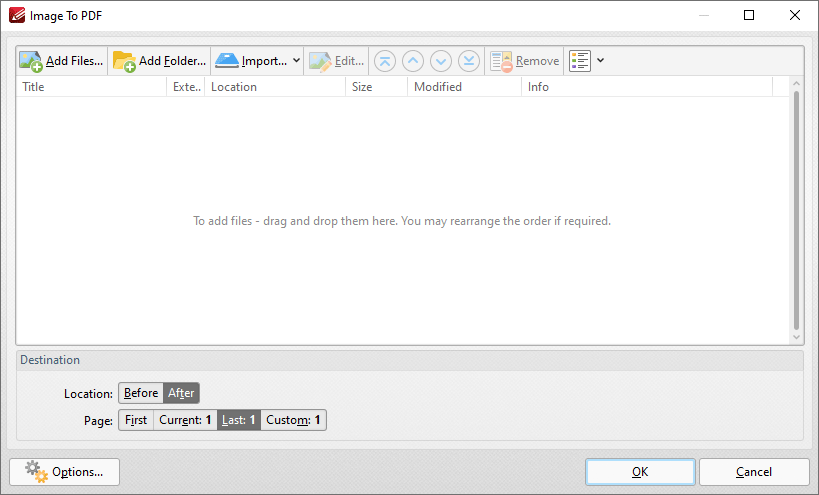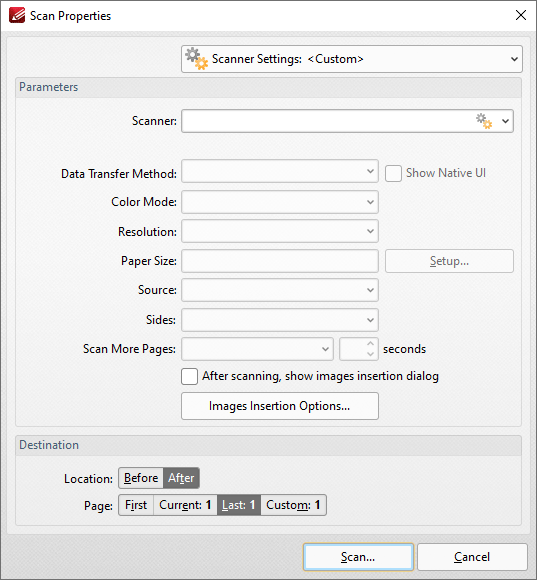 Insert
Insert
Click Insert to view page insertion options:

Figure 1. Organize Tab, Insert
Click Insert Pages to insert pages into the active document:

Figure 2. Insert Pages Dialog Box
•Select From File to insert pages from a file into the active document.
•Use the Actions with Objects options to determine the action taken for Comments, Form Fields and Bookmarks contained in the inserted pages.
•Select the Add root bookmark, with file name box to create a root bookmark from inserted pages.
•Use the Page Range options to determine which pages are inserted:
•Select All to specify all pages.
•Select Custom to specify a custom page range, then enter the desired page range in the adjacent number box. Further information about how to specify custom page ranges is available here.
•Use the Subset options to specify a subset of selected pages. Select All, Odd or Even as desired.
•Use the Destination options to determine the location at which the new pages are inserted.
Click OK to insert pages.
Click Insert Empty Pages to insert empty pages into the active document:

Figure 3. Insert Empty Pages Dialog Box
•Select an option in the Pages section to determine the dimensions of new pages:
•Select Document to match the dimensions of the current document.
•Select Standard to select a standard document size, such as those used by the ISO and ANSI.
•Select Custom to enter custom dimensions. Enter the desired dimensions into the number boxes.
•Select either Portrait or Landscape for the orientation of new pages.
•Use the Count menu to determine the number of pages inserted.
•Use the Destination options to determine the location at which the new pages are inserted.
Click OK to insert the empty pages.
Click Insert Pages from Clipboard to insert pages from the clipboard on your machine:

Figure 4. Insert Pages from Clipboard Dialog Box
The current clipboard content on your machine is detailed in the dialog box. Select the content that you want to insert as a page, then use the Location and Page options to specify the location at which you want to insert the pages and click OK to perform the operation. Click Options for additional insertion options. Note that the options available depend on the type of content that you are inserting into the document.
Click Insert Images to insert images into the active document:

Figure 5. Images to PDF Dialog Box
•Click Add Files to add images to the list of source files.
•Click Add Folder to add folders of images to the list of source files.
•Click Import to add images from the local scanner. See here for further details.
•Click Edit to edit selected images before insertion.
•Use the blue arrow icons to reorder images. The order of images in the Image to PDF dialog box determines the order in which images are inserted into the active document.
•Click Remove to remove selected images.
•Use the Change View Mode button to select Details, Icons or Thumbnails as the display mode of list items.
•Use Destination options to determine at which images are inserted.
•Click Options to determine the options for inserted images. See here for further details.
Click OK to insert images.
Click Insert Scanned Pages to insert scanned pages into the active document:

Figure 6. Scan Properties Dialog Box
•Click the Scanner Settings menu to select a preset scanning mode.
•Click the Scanner menu to select a scanner.
•Click the Data Transfer Method menu to select either Native Mode or Memory Mode:
•Native Mode uses a single memory buffer. This is the default and fastest mode, and is compatible with the broadest range of scanners.
•Memory Mode enables the use of multiple memory buffers. This is a useful function in cases where memory is low and/or when large images are scanned.
•The Show Native UI box is selected by default, which means the user interface of the device driver is used. This is the most reliable option, and the scanner will select certain parameters of the scan itself: Color Mode, Resolution, Paper Size and Source. Clear the Show Native UI box to customize these options:
•Color Mode has four options: Auto detect, Color, Grayscale and Black & White. These refer to the format of scanned documents.
•Click the Resolution menu to select the DPI (dots per inch) of scanned documents.
•Paper Size refers to the size of the paper used when scanning. Click Setup for further options:
•Automatic set the paper size automatically.
•Standard contains standard sizes such as those used by the ISO and ANSI.
•Custom can be used to enter custom dimensions.
•Source has three options Auto, Flatbed and Feeder. These refer to the type of scanner used.
•Click Sides to determine which sides of documents are scanned. There are three options: Simple Scan, Manual Duplex and Manual Duplex Reversed. Click the dropdown arrow for an explanation of these options.
•Click Scan More Pages to determine when additional pages are scanned.
•Select the After scanning, show images insertion dialog box to view the images insertion dialog box after the scan has been performed. This enables the customization of images and image settings.
•Click Images Insertion Options to determine further options for images. These options are detailed here.
•Use the Destination options to determine the location at which scanned pages are inserted.
•Please note that the Save Current Settings option in the Scanner Settings dropdown menu can be used to save customized settings.
Click Scan to scan images.
Click Insert Text to insert text files into the active document:

Figure 7. Convert Text Files to PDF Dialog Box
•Click Add Files to add text files to the list of source files.
•Click Add Folder to add all text files from a folder to the list of source files.
•Use the blue arrows to reorder files. The order of files in the list determines the order in which they are added to the document.
•Click Remove to remove selected files.
•Select files to enable the Selected File Options:
•Text Encoding determines character encoding of text.
•New Paragraph Mode determines how PDF-XChange Editor defines paragraphs in inserted text:
•Auto-Detect searches for and identifies paragraphs automatically.
•Each newline character starts a new paragraph. (A newline is a special character in computing that signifies the end of a line of text).
•Two newline characters start a new paragraph, single is ignored.
•A double newline character starts a new paragraph, a single is converted to a space.
•Place File Mode determines how files are placed:
•Start each file from new paragraph places each file in a new paragraph, and files can share the same page.
•Start each file from new page places each file in a new page.
•Use the Destination options to determine the location at which scanned pages are inserted.
•Click Options to determine the options for inserted text files, as detailed here.
Click OK to insert text files.
Click Insert RTF to insert RTF files into documents:

Figure 8. Convert RTF Files to PDF Dialog Box
•Click Add Files to add RTF files to the list of source files.
•Click Add Folder to add all RTF files from a folder to the list of source files.
•Use the blue arrows to reorder files. The order of files in the list determines the order in which they are added to the document.
•Click Remove to remove selected files.
•Use the Destination options to determine the location at which files are inserted.
•Click Options to determine the relative path options for inserted files.
Click OK to insert files.